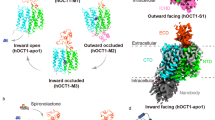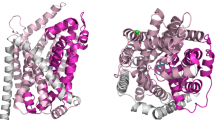Abstract
Purpose
The objective was to elucidate the inhibition requirements of the human organic cation/carnitine transporter (hOCTN2).
Methods
Twenty-seven drugs were screened initially for their potential to inhibit uptake of l-carnitine into a stably transfected hOCTN2-MDCK cell monolayer. A HipHop common features pharmacophore was developed and used to search a drug database. Fifty-three drugs, including some not predicted to be inhibitors, were selected and screened in vitro.
Results
A common features pharmacophore was derived from initial screening data and consisted of three hydrophobic features and a positive ionizable feature. Among the 33 tested drugs that were predicted to map to the pharmacophore, 27 inhibited hOCTN2 in vitro (40% or less l-carnitine uptake from 2.5 μM l-carnitine solution in presence of 500 μM drug, compared to l-carnitine uptake without drug present). Hence, the pharmacophore accurately prioritized compounds for testing. K i measurements showed low micromolar inhibitors belonged to diverse therapeutic classes of drugs, including many not previously known to inhibit hOCTN2. Compounds were more likely to cause rhabdomyolysis if the C max/K i ratio was higher than 0.0025.
Conclusion
A combined pharmacophore and in vitro approach found new, structurally diverse inhibitors for hOCTN2 that may possibly cause clinical significant toxicity such as rhabdomyolysis.





Similar content being viewed by others
Abbreviations
- MDCK:
-
Madin–Darby canine kidney
- OCTN2:
-
organic cation/carnitine transporter
- QSAR:
-
quantitative structure activity relationship
References
Dresser MJ, Leabman MK, Giacomini KM. Transporters involved in the elimination of drugs in the kidney: organic anion transporters and organic cation transporters. J Pharm Sci. 2001;90(4):397–421. doi:10.1002/1520-6017(200104)90:4<397::AID-JPS1000>3.0.CO;2-D
Rebouche CJ, Paulson DJ. Carnitine metabolism and function in humans. Annu Rev Nutr. 1986;6:41–66. doi:10.1146/annurev.nu.06.070186.000353.
Matsuishi T, Yoshino M, Kato H, Ohura T, Tsujimoto G, Hayakawa J, et al. Primary systemic carnitine deficiency is caused by mutations in a gene encoding sodium ion-dependent carnitine transporter. Nat Genet. 1999;21(1):91–4. doi:10.1038/5030.
Wang Y, Ye J, Ganapathy V, Longo N. Mutations in the organic cation/carnitine transporter OCTN2 in primary carnitine deficiency. Proc Natl Acad Sci U S A. 1999;96(5):2356–60. doi:10.1073/pnas.96.5.2356.
Christopher-Stine L. Statin myopathy: an update. Curr Opin Rheumatol. 2006;18(6):647–53.
Ohashi R, Tamai I, Yabuuchi H, Nezu JI, Oku A, Sai Y, et al. Na(+)-dependent carnitine transport by organic cation transporter (OCTN2): its pharmacological and toxicological relevance. J Pharmacol Exp Ther. 1999;291:778–84.
Grube M, Meyer zu Schwabedissen HE, Präger D, Haney J, Möritz KU, Meissner K, et al. Uptake of cardiovascular drugs into the human heart: expression, regulation, and function of the carnitine transporter OCTN2 (SLC22A5). Circulation 2006;113(8):1114–22.
Wagner CA, Lukewille U, Kaltenbach S, Moschen I, Broer A, Risler T, et al. Functional and pharmacological characterization of human Na(+)-carnitine cotransporter hOCTN2. Am J Physiol Renal Physiol. 2000;279:F584–591.
Clement OO, Mehl AT. HipHop: pharmacophore based on multiple common-feature alignments. In: Guner OF, editor. Pharmacophore perception, development, and use in drug design. San Diego: IUL; 2000. p. 69–84.
Ekins S, Chang C, Mani S, Krasowski MD, Reschly EJ, Iyer M, et al. Human pregnane X receptor antagonists and agonists define molecular requirements for different binding sites. Mol Pharmacol. 2007;72:592–603. doi:10.1124/mol.107.038398.
Ganapathy ME, Huang W, Rajan DP, Carter AL, Sugawara M, Iseki K, et al. Beta-lactam antibiotics as substrates for OCTN2, an organic cation/carnitine transporter. J Biol Chem. 2000;275:1699–707.
Chang C, Ekins S, Bahadduri P, Swaan PW. Pharmacophore-based discovery of ligands for drug transporters. Adv Drug Deliv Rev. 2006a;58:1431–50.
Chang C, Bahadduri PM, Polli JE, Swaan PW, Ekins S. Rapid identification of P-glycoprotein substrates and inhibitors. Drug Metab Dispos. 2006b;34(12):1976–84.
Ekins S, Johnston JS, Bahadduri P, D’Souzza VM, Ray A, Chang C, Swaan PW. In vitro and pharmacophore based discovery of novel hPEPT1 inhibitors. Pharm Res. 2005;22:512–7.
Akarawut W, Lin CJ, Smith DE. Noncompetitive inhibition of glycylsarcosine transport by quinapril in rabbit renal brush border membrane vesicles: effect on high-affinity peptide transporter. J Pharmacol Exp Ther. 1998;287(2):684–90.
Koepsell H, Lips K, Volk C. Polyspecific organic cation transporters: structure, function, physiological roles, and biopharmaceutical implications. Pharm Res. 2007;24(7):1227–51.
Kuntzer T, Reichmann H, Bogousslavsky J, Regli F. Emetine-induced myopathy and carnitine deficiency. J Neurol. 1990;237:495–6.
Tune BM. Effects of l-carnitine on the renal tubular transport of cephaloridine. Biochem Pharmacol. 1995;50(4):562–4.
Tune BM, Hsu CY. Toxicity of cephaloridine to carnitine transport and fatty acid metabolism in rabbit renal cortical mitochondria: structure-activity relationships. J Pharmacol Exp Ther. 1994;270(3):873–80.
Luck RP, Verbin S. Rhabdomyolysis: a review of clinical presentation, etiology, diagnosis, and management. Pediatr Emerg Care 2008;24(4):262–8.
Morris AA, Turnbull DM. Fatty acid oxidation defects in muscle. Curr Opin Neurol. 1998;11(5):485–90.
Fowler S, Zhang H. In vitro evaluation of reversible and irreversible cytochrome P450 inhibition: current status on methodologies and their utility for predicting drug–drug interactions. AAPS J. 2008;10(2):410–24.
Todesco L, Bur D, Brooks H, Török M, Landmann L, Stieger B, et al. Pharmacological manipulation of l-carnitine transport into L6 cells with stable overexpression of human OCTN2. Cell Mol Life Sci. 2008;65(10):1596–608.
Seth P, Wu X, Huang W, Leibach FH, Ganapathy V. Mutations in novel organic cation transporter (OCTN2), an organic cation/carnitine transporter, with differential effects on the organic cation transport function and the carnitine transport function. J Biol Chem. 1999;274(47):33388–92.
Acknowledgments
This work was supported in part by National Institutes of Health grant DK67530. The authors kindly acknowledge Dr. Xin Ming and Dr. Dhiren R. Thakker (University of North Carolina-Chapel Hill) for providing the hOCTN2-MDCK cell line used in this study. The authors gratefully acknowledge Dr. Matthew D. Krasowski for his assistance in creating the SCUT 2008 database supplemented with metabolites and drugs of abuse. The authors also thank Accelrys, San Diego, CA for making Discovery Studio Catalyst available.
Author information
Authors and Affiliations
Corresponding author
Electronic Supplementary Material
Below is the link to the electronic supplementary material.
ESM 1
(DOC 522 KB)
Rights and permissions
About this article
Cite this article
Diao, L., Ekins, S. & Polli, J.E. Novel Inhibitors of Human Organic Cation/Carnitine Transporter (hOCTN2) via Computational Modeling and In Vitro Testing. Pharm Res 26, 1890–1900 (2009). https://doi.org/10.1007/s11095-009-9905-3
Received:
Accepted:
Published:
Issue Date:
DOI: https://doi.org/10.1007/s11095-009-9905-3




